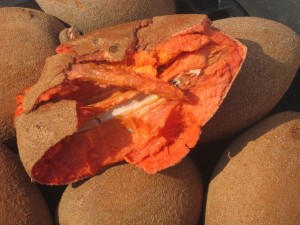 When he escaped on the uninhabited island of Roatan, Philip Ashton desperately needed to find food — but he did not recognize many of the tropical fruits growing wild in the woods. He was reluctant to try many of these fruits, including mango, which he thought were poison. One of the strangest fruits he encountered had a brown, fuzzy skin and was about the size of a pear. It had a thick outer skin, but broke open easily when struck against a rock or tree trunk or, sometimes, when it fell from the tree and hit the ground.
When he escaped on the uninhabited island of Roatan, Philip Ashton desperately needed to find food — but he did not recognize many of the tropical fruits growing wild in the woods. He was reluctant to try many of these fruits, including mango, which he thought were poison. One of the strangest fruits he encountered had a brown, fuzzy skin and was about the size of a pear. It had a thick outer skin, but broke open easily when struck against a rock or tree trunk or, sometimes, when it fell from the tree and hit the ground.
This was the sapote fruit, which is native to Central America and the Caribbean, although the name Ashton uses in his narrative is “Mammees saporters” — and even today, islanders still call it the mamey apple. The inside of the sapote is mushy, like a banana, with a bright pinkish-orange color. Ashton didn’t dare eat these at first. But before long, he saw wild hogs eating the fruit where it had fallen to the ground, and he decided they probably weren’t poisonous. So he tried one. The soft inner-fruit had a custardy taste similar to watermelon. Ashton ate many of the sapote, describing it as a “very delicious sort of fruit.”
Because sapote were a staple in Ashton’s diet during his time on the island, I was determined to find some sapote fruit when I went to Roatan to research my new book about Philip Ashton, At the Point of a Cutlass, published this summer. But the trees can be hard to find today. After a long, winding trek through the thick woods, my guide Randy Matute found a tree with fresh sapote growing on it — which he proceeded to climb in order to knock down several of the sapote fruit onto the ground.
At the Point of a Cutlass, now in its ninth week on the Boston Globe bestsellers list for nonfiction, is on sale now.






